Physical Address
304 North Cardinal St.
Dorchester Center, MA 02124
Physical Address
304 North Cardinal St.
Dorchester Center, MA 02124
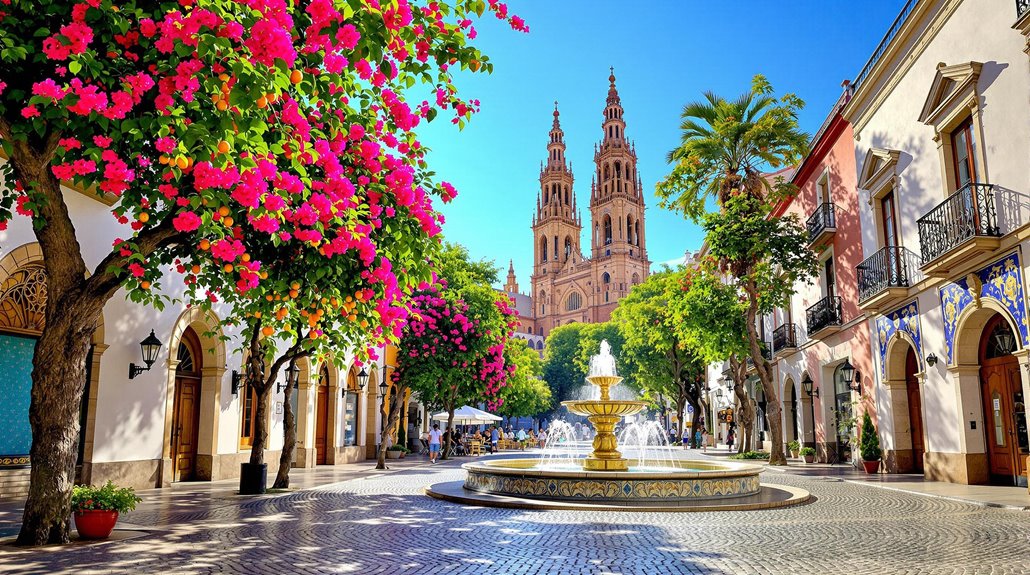
Spain’s must-visit destinations showcase the country’s diverse heritage, from Barcelona’s soaring Sagrada Familia to Granada’s intricate Alhambra Palace. You’ll discover Madrid’s acclaimed art museums, San Sebastian’s world-class cuisine, and Toledo’s fascinating three-culture legacy. Don’t miss Galera’s unique cave houses, Jerez’s sherry bodegas, or the stunning Sierra Nevada Mountains. These iconic sites offer just a glimpse of Spain’s architectural marvels, natural wonders, and cultural treasures waiting to be explored.
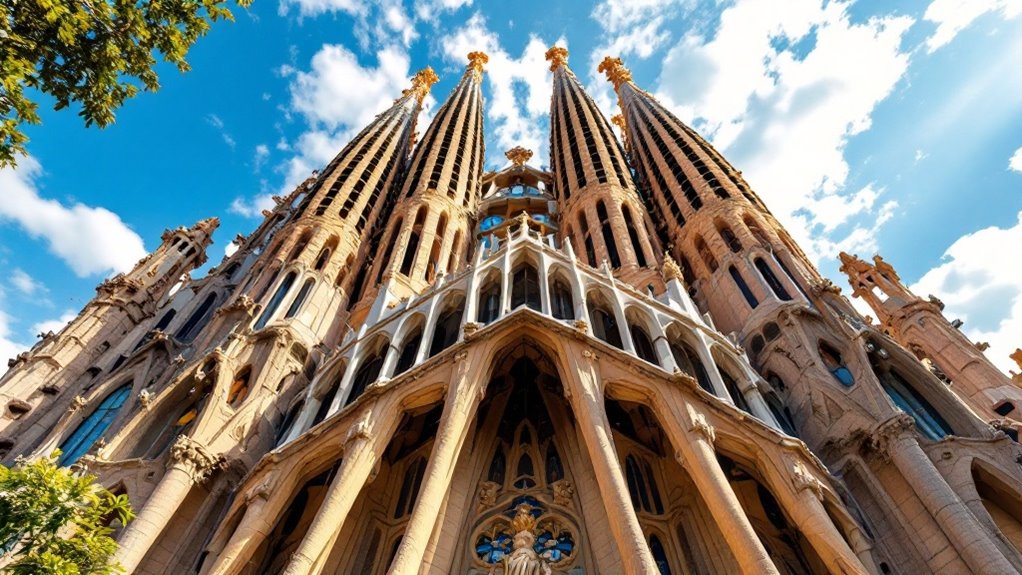
When you step inside Barcelona’s Sagrada Familia, you’ll immediately understand why this architectural marvel has captivated visitors for over a century.
From the moment you enter, the Sagrada Familia’s breathtaking design reveals why it’s Barcelona’s most awe-inspiring landmark.
The soaring columns, designed like branching trees, reach heights of 45 meters in the central nave, while the stunning vaults create a graduated ceiling that seems to touch the heavens.
You’ll want to visit during opening hours or last entry slots to avoid crowds, and plan to spend about two hours exploring the basilica and museum.
For the best experience, purchase your €36 tower access ticket to fully appreciate Gaudí’s masterpiece.
Construction began in 1882 and will finally complete in 2026, when its 170-meter central tower will make it the world’s tallest church, marking the end of a remarkable 144-year journey.
The basilica’s interior showcases extraordinary non-flat surface designs that feature rich ornamentation comprised of abstract shapes throughout.
Three magnificent museums form Madrid’s prestigious Golden Triangle of Art, creating one of Europe’s most concentrated collections of artistic masterpieces.
You’ll discover the historic Museo del Prado, showcasing Spanish royal collections and masterworks by Velázquez and Goya; the Reina Sofía Museum, home to Picasso’s powerful “Guernica” and contemporary art; and the Thyssen-Bornemisza Museum, which bridges artistic periods with its diverse collection of 1,600 paintings.
Madrid’s vibrant art scene includes over 70 museums throughout the city.
To make the most of your visit, you’ll want to purchase skip-the-line tickets or a Madrid Card for seamless access.
Take advantage of free entry times in the evenings, and plan to spend at least three hours at each museum.
Consider breaking up your visits with strolls through nearby Retiro Park, and don’t miss the guided tours for deeper insights into these remarkable collections.
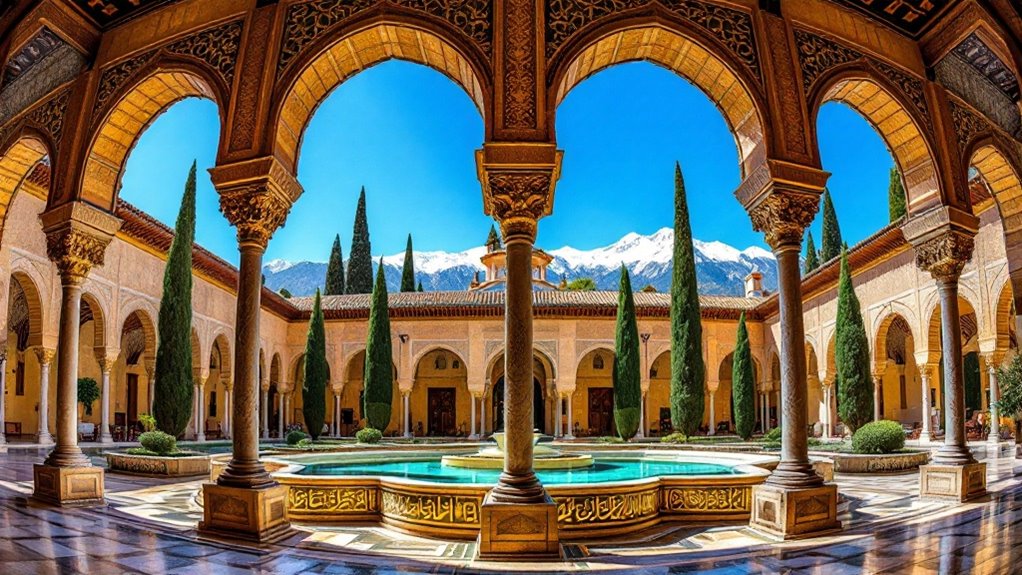
Moving south from Madrid’s artistic treasures, you’ll discover Spain’s most magnificent Moorish palace complex perched above the city of Granada. The Alhambra, built in 1238, showcases stunning Islamic architecture with its intricate geometric patterns, carved stucco, and serene courtyards featuring mesmerizing water elements. The complex has been a UNESCO World Heritage Site since 1984.
| Area | Must-See Features | Time Needed |
|---|---|---|
| Nasrid Palaces | Comares Palace, Court of Lions | 90 minutes |
| Alcazaba | Military fortress, panoramic views | 45 minutes |
| Generalife | Summer palace, terraced gardens | 60 minutes |
| Charles V Palace | Renaissance architecture, circular courtyard | 30 minutes |
You’ll need to book tickets in advance, as daily visitor numbers are limited. Plan your visit for May or September to avoid crowds and extreme temperatures, and don’t forget to bring your ID matching your reservation.
Located in Spain’s stunning Basque Country, San Sebastian stands as one of Europe’s most celebrated culinary destinations, where you’ll discover an extraordinary concentration of Michelin-starred restaurants and lively pintxos bars.
San Sebastian shines as the Basque Country’s culinary crown jewel, where Michelin stars and buzzing pintxos bars create an unmatched food lover’s paradise.
When you visit, you’ll want to experience these essential culinary highlights:
Don’t miss the fresh seafood at Ondarreta Fish Market, and be sure to try the region’s crisp Txakoli wines, perfectly paired with local specialties. The city’s commitment to seasonal food from scratch means you’ll always enjoy the freshest ingredients prepared with authentic Basque techniques.
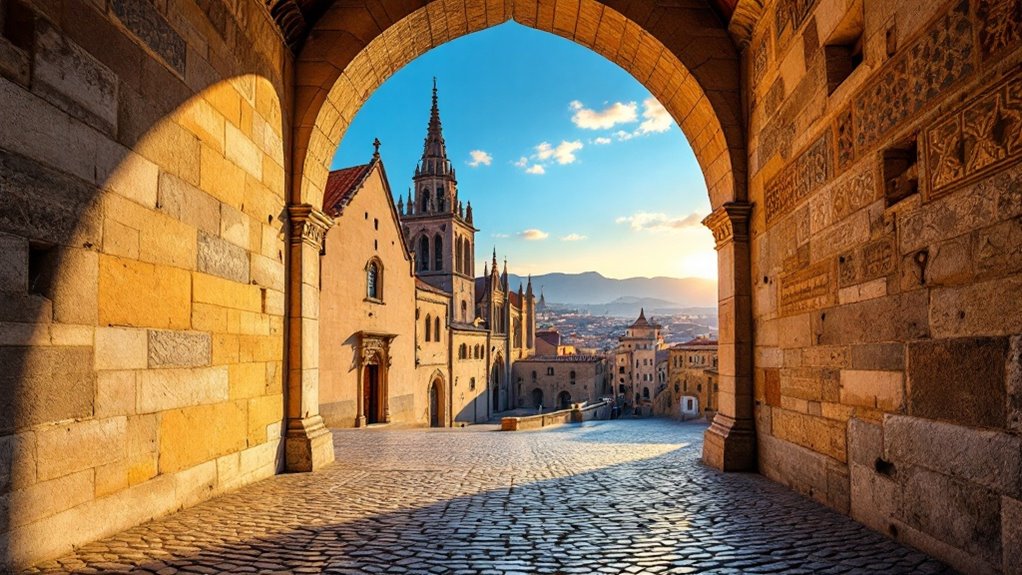
Standing as Spain’s most remarkable proof of religious coexistence, Toledo showcases an extraordinary blend of Christian, Jewish, and Islamic heritage within its medieval walls.
You’ll encounter this UNESCO World Heritage site packed with over 100 protected monuments across its historic center, where 2,000 years of architectural layers tell fascinating stories of cultural fusion. The city’s strategic location on a rugged promontory, surrounded by the Tagus River, made it an ideal defensive stronghold throughout history.
Don’t miss the Cristo de la Luz Mosque with its original Moorish arches, the stunning Synagogue of Santa María la Blanca with Islamic-style decorations, and the Gothic Toledo Cathedral housing El Greco masterpieces.
As you explore the Jewish Quarter, you’ll uncover the El Tránsito Synagogue, now a Sephardic Museum, while the School of Translators site reveals Toledo’s pivotal role in bridging medieval European and Arabic knowledge.
Six spectacular buildings form Valencia’s awe-inspiring City of Arts and Sciences, a futuristic complex spanning 350,000 square meters along the former Turia riverbed.
Designed by architects Santiago Calatrava and Félix Candela, this architectural marvel combines white concrete, glass facades, and water elements to create stunning visual harmony. Since its inauguration in 1998, the complex has become one of Spain’s most visited modern tourist destinations.
Bold architectural vision meets graceful design as white concrete, glass, and water unite in perfect aesthetic balance.
You’ll need at least 6-8 hours to explore the main attractions:
Consider purchasing combo tickets for the best value, and don’t miss the complex’s illuminated architecture at night.
The Valencia Tourist Card offers a 10% discount on entry fees, making it a smart choice for visitors.
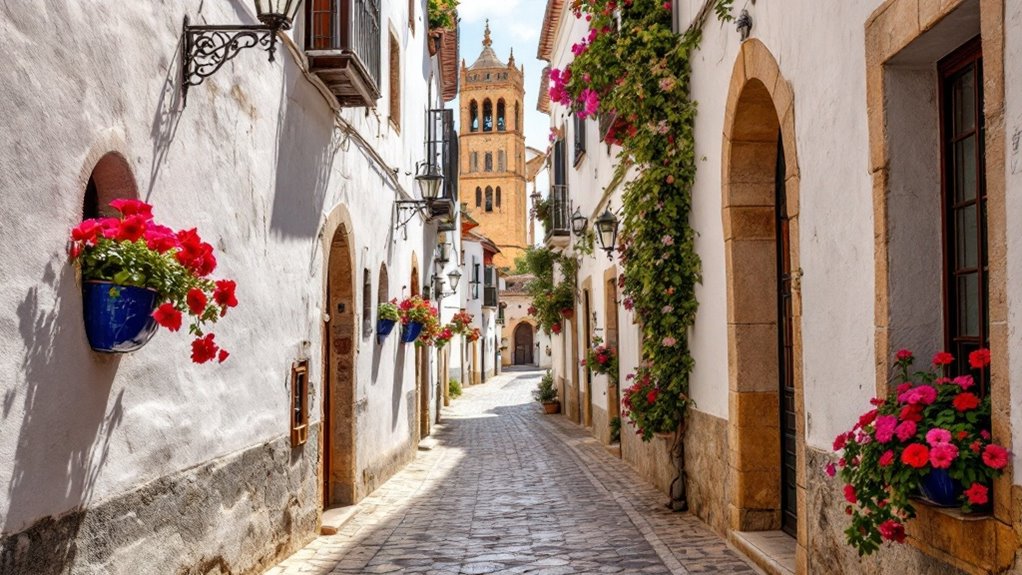
As you wander through Córdoba’s labyrinthine streets, you’ll discover a mesmerizing blend of Roman, Islamic, Jewish, and Christian influences that have shaped this UNESCO World Heritage Site over millennia. From the geometric patterns of black-and-white river stones called *enchinado cordobés* beneath your feet to the stunning casa-patio houses with their flower-filled courtyards, every corner reveals centuries of history. The city experienced its golden cultural peak between the 8th and 10th centuries as a major urban center of the western world. These enchanting streets have earned Córdoba a place among Spain’s hidden cultural treasures that deserve exploration.
| Must-See Landmarks | Time to Visit | Key Features |
|---|---|---|
| Great Mosque-Cathedral | Morning | 8th-century architecture |
| Roman Bridge | Sunset | 16 arches, river views |
| Jewish Quarter | Afternoon | Whitewashed houses |
| Alcázar Fortress | Mid-day | Gothic architecture |
| Calahorra Tower | Morning | Defensive structure |
Don’t miss the Zoco de los Artesanos, where local craftsmen keep ancient traditions alive in a restored Moorish courtyard.
Within Seville’s historic heart, the Royal Alcázar stands as Europe’s oldest continuously used royal palace, blending over 1,000 years of architectural mastery and cultural fusion. Originally built in 913 AD, this magnificent structure has evolved from a fortified palace into a testament of Andalusian heritage.
You’ll want to book your tickets in advance, as this UNESCO World Heritage site draws crowds year-round, especially during peak midday hours.
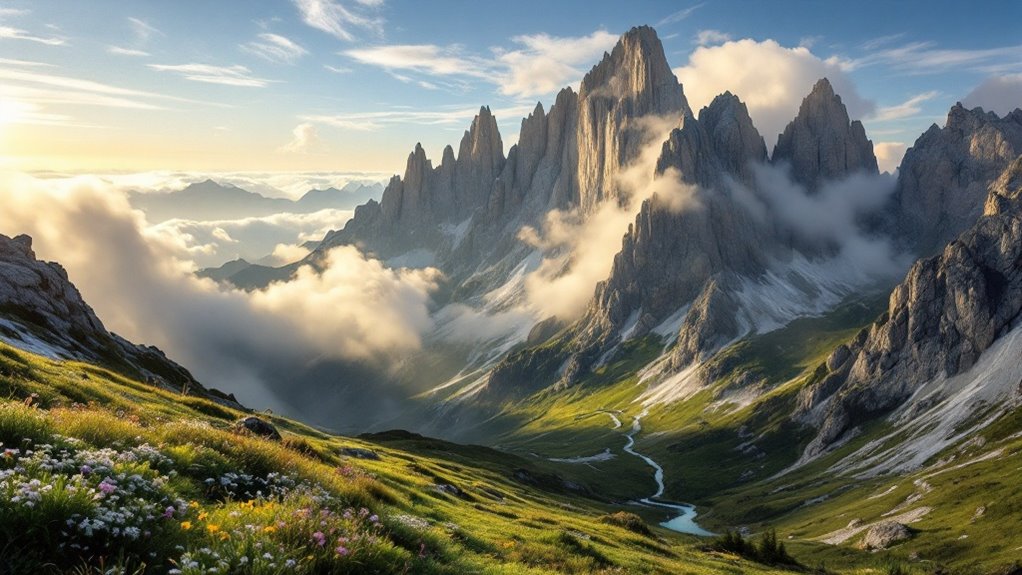
Moving from Seville’s ornate palace to Spain’s dramatic northern wilderness, the majestic Picos de Europa stands as the country’s first and most spectacular national park.
From grand palaces to pristine wilderness, Spain’s Picos de Europa proudly reigns as its pioneering national park achievement.
You’ll discover a diverse wonderland of limestone peaks, deep gorges, and mixed forests spread across three regions, with the towering Torre de Cerredo reaching 2,648 meters into the sky.
For the best experience, visit between May and September when the weather’s most stable. You can’t miss the iconic Ruta del Cares, a 23.6-kilometer trail that winds through breathtaking gorges, or take the Fuente Dé cable car for easier access to high-altitude routes.
While exploring, you might spot Cantabrian brown bears, wolves, or the endemic chamois.
The park recorded its most extreme temperature in January 2021, when Vega de Liordes plummeted to a bone-chilling -35.8°C.
Base yourself in towns like Poncebos or Cangas de Onís, and don’t forget to visit the historic Covadonga Sanctuary.
Perched dramatically atop a 750-meter plateau, the medieval town of Ronda captivates visitors with its stunning position above the 120-meter-deep El Tajo gorge.
The construction of the town’s most famous bridge took determination, as the Puente Nuevo took 40 years to complete before its final unveiling in 1793.
You’ll discover a rich blend of Roman, Moorish, and Christian history as you explore this ancient settlement, where the iconic Puente Nuevo bridge stands as a symbol of remarkable engineering.
Don’t miss these essential experiences:
As you wander through the whitewashed streets, you’ll understand why literary giants like Hemingway were so captivated by Ronda’s dramatic landscapes and romantic atmosphere.
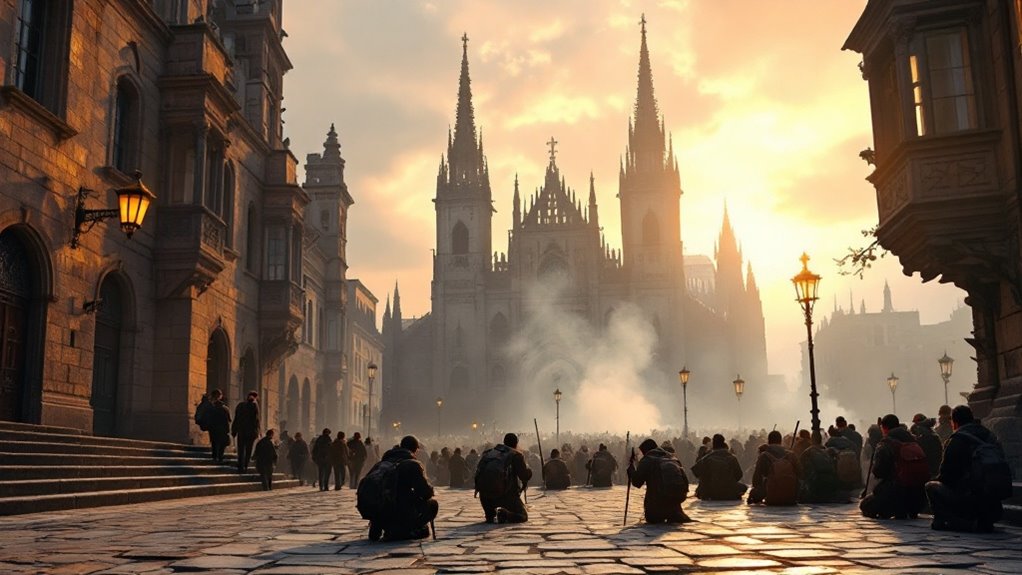
As you complete your transformative journey along the Camino de Santiago, you’ll discover yourself arriving at the magnificent Cathedral of Santiago de Compostela, where centuries of pilgrims have culminated their spiritual quest.
You can join the daily Pilgrim’s Mass at noon, where you’ll witness the spectacular Botafumeiro, a massive silver incense burner, swinging through the cathedral during special ceremonies.
To receive your cherished Compostela certificate, you’ll need to have walked at least 100km (or cycled 200km) to Santiago, collecting stamps in your Credencial passport along the way.
Don’t miss embracing St. James’s statue in the cathedral’s crypt or touching the worn central pillar, and if you’re feeling adventurous, you can continue another 89km to Fisterra, where pilgrims traditionally mark their renewal at the “End of the World.”
After completing your pilgrimage, take time to explore the city’s cozy cafes and streets while celebrating with fellow travelers you’ve met along your journey.
Nestled in northern Spain along the meandering Ebro River, La Rioja stands as the country’s most celebrated wine region, where you’ll discover over 65,000 hectares of sun-drenched vineyards stretching across three distinct sub-regions.
La Rioja’s endless vineyards paint a sun-soaked canvas across northern Spain, making it the crown jewel of Spanish winemaking.
You can explore this remarkable region through its world-class wineries, historic landmarks, and dynamic culture. Ancient winemaking traditions here trace back to the Roman settlement era.
While you’re here, don’t miss the chance to taste the region’s famous Tempranillo-based reds, which account for 85% of production.
Or join the lively Batalla del Vino festival in June, where locals celebrate with a massive wine fight.
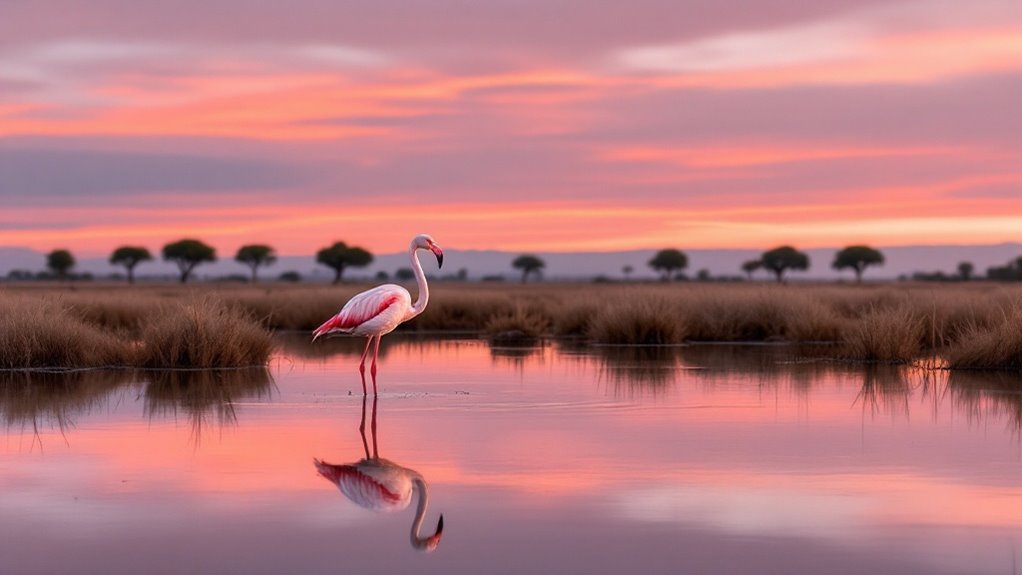
From Spain’s renowned wine country, you’ll want to head south to discover one of Europe’s most remarkable wildlife sanctuaries. At Doñana National Park, you’ll witness an extraordinary convergence of ecosystems where over 500,000 waterfowl spend their winters among Europe’s largest dune system and vast wetlands. The park’s location near the Guadalquivir River provides essential water resources that sustain its diverse habitats.
| Wildlife Highlights | Best Time to Visit |
|---|---|
| Iberian Lynx | Winter (Dec-Feb) |
| Flamingo Colonies | Spring (Mar-May) |
| Spanish Imperial Eagle | Fall (Sep-Nov) |
| Migratory Waterfowl | Winter (Dec-Feb) |
As you explore the park’s 30,000 hectares, you’ll encounter an impressive mix of permanent lagoons, Mediterranean scrub, and pine forests. Don’t miss the chance to spot some of Spain’s rarest species, including the endangered Iberian lynx and marbled teal, while experiencing one of UNESCO’s most cherished World Heritage Sites.
Perched dramatically on limestone cliffs above the Huécar gorge, Cuenca’s famous hanging houses (casas colgadas) stand as remarkable testimonies to medieval Spanish ingenuity.
Defying gravity and time, Cuenca’s hanging houses cling to ancient cliffs, showcasing medieval Spain’s architectural daring.
These 15th-century architectural marvels feature wooden balconies that extend over a 100-meter drop, offering breathtaking views of the surrounding landscape. The houses are particularly enchanting when viewed during nighttime illumination.
You’ll find the best ways to experience these UNESCO-listed structures:
For the most impressive views, time your visit during golden hour when the sun illuminates the wooden balconies and stone facades in warm, amber hues.
Standing majestically along the Cerro Calderico ridge, the iconic windmills of Consuegra transport you back to medieval Spain, where these storied sentinels have watched over La Mancha’s arid plains for more than four centuries.
You’ll discover 12 preserved windmills, made famous by Cervantes’ “Don Quixote,” where his protagonist mistook them for giants.
Just 130 km south of Madrid, you can easily reach these whitewashed structures by car or bus from Toledo.
Don’t miss Molino Sancho, which houses a small museum and working mill mechanisms. Of the dozen windmills, four still retain their original wooden machinery, including the impressive oak frameworks and poplar wood blades.
The site offers free parking, and you’ll encounter wheelchair-accessible pathways leading to these remarkable heritage monuments. For a unique dining experience, visit the Gastromolino restaurant housed within one of the windmills, offering wine and tapas with panoramic views.
While La Mancha’s windmills recall literary adventures, the Gothic Cathedral of Burgos represents Spain’s greatest architectural achievements.
Built with limestone from Hontoria quarried nearby, you’ll be awestruck by its magnificent twin spires soaring 84 meters high, inspired by Germany’s Cologne Cathedral. This UNESCO World Heritage site, built between 1221 and 1567, showcases stunning French Gothic architecture with remarkable Renaissance additions.
Inside, you’ll discover:
You can visit daily, with audio guides available in multiple languages.
Located in Burgos’ historic center, it’s easily accessible by bus or train from Madrid in about 2.5 hours.
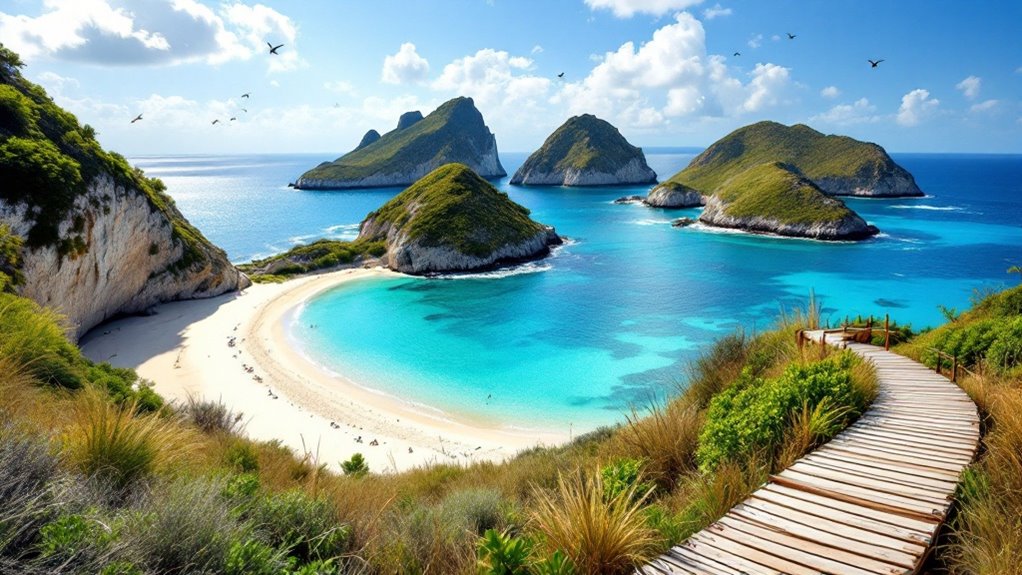
Off the rugged Galician coast of Spain, the breathtaking Cíes Islands archipelago beckons visitors with its pristine beaches, crystal-clear waters, and remarkable biodiversity.
You’ll discover three main islands, connected by the stunning Rodas Beach, which The Guardian once named the world’s best. The highest elevation point on the islands is Alto das Cíes, reaching an impressive 197 meters above sea level.
You’ll need to plan ahead since only 2,200 daily visitors are allowed, and you must secure permits in advance.
Take a ferry from Vigo, Cangas, or Baiona to explore hiking trails leading to the Monte Faro Lighthouse, or go snorkeling in the Atlantic waters.
Don’t miss the opportunity to spot Europe’s largest yellow-legged gull colony and various marine life, including dolphins and octopuses.
Remember there aren’t any trash bins, so you’ll need to follow the strict “leave no trace” policy.
From the Atlantic coast’s natural wonders, Spain’s architectural marvels await in the heart of Granada province. The remarkable cave houses of Galera, carved into soft sedimentary rock hillsides, offer you a unique blend of history and modern comfort.
Nestled in Granada’s heart, Galera’s ancient cave dwellings merge centuries-old craftsmanship with modern living among the Spanish hillsides.
These fascinating dwellings, dating back to the Moorish occupation, maintain a pleasant 18°C temperature year-round while featuring contemporary amenities. The area’s low crime rate makes it an exceptionally safe destination for travelers exploring the village.
You’ll discover a destination that perfectly balances tradition with comfort:
When you visit these cave houses, you’re experiencing a crucial piece of Andalusia’s cultural heritage, where ancient agricultural traditions meet present-day sustainable living.
The surrounding areas near Lake Negratín offer additional exploration opportunities.
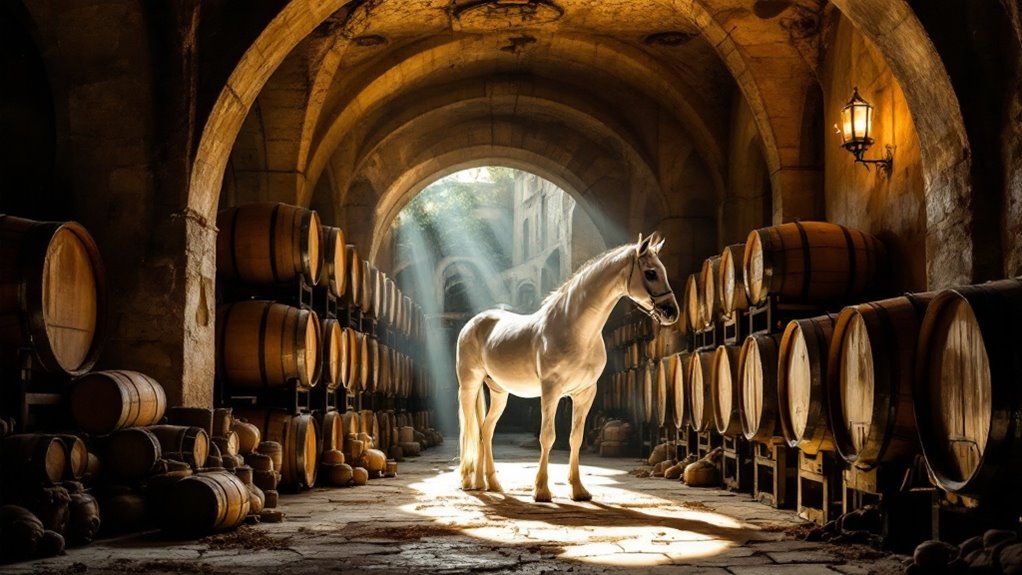
Deep in southern Spain, Jerez beckons wine enthusiasts and equestrian lovers with its twin treasures: world-renowned sherry production and magnificent Andalusian horses.
Situated at latitude 36º North, Jerez enjoys exceptionally warm summers that help create its distinctive wines.
You’ll discover over 3,000 years of winemaking heritage in the region’s bodegas, where the traditional solera system ages sherries across generations. While touring historic wineries like Lustau, you can taste distinctive varieties made from Palomino and Pedro Ximénez grapes.
Don’t miss the spectacular horse shows at the Real Escuela Andaluza del Arte Ecuestre, where you’ll see majestic Cartujano horses perform intricate dressage routines every Tuesday and Thursday.
If you’re visiting in May, plan your trip around the Feria del Caballo, where you can experience the city’s equestrian culture through parades, competitions, and lively flamenco performances.
Spain’s majestic Sierra Nevada Mountains rise dramatically from the Mediterranean coast, offering you year-round adventures that complement the cultural richness of Andalusia.
You’ll discover Europe’s southernmost ski resort here, with over 100 kilometers of pistes reaching up to 3,300 meters in elevation, while summer brings excellent hiking opportunities around picturesque villages like Pampaneira and Capileira.
Whether you’re seeking snowy slopes or Mediterranean charm, the Sierra Nevada delivers unforgettable experiences in every season.
Three distinct medieval boroughs unite to form Pamplona’s enchanting historic center, where Renaissance fortifications and Gothic masterpieces tell stories of the city’s rich past.
You’ll discover architectural gems like the Gothic-style Pamplona Cathedral, with its stunning neoclassical facade and medieval cloister, alongside the Baroque City Hall where the famous San Fermín festival begins each year.
Wander through the 5-kilometer city walls, now a National Monument, for panoramic views of the old town.
Don’t miss Plaza del Castillo, the city’s lively heart, where you can sample local pamplonica at outdoor cafes.
The 16th-century Citadel, now transformed into a cultural center, hosts art exhibitions and concerts, while Calle Estafeta’s pintxo bars offer authentic Basque flavors.
You will discover ideal beach conditions during September-October when sea temperatures remain swimmable (17-24°C), crowds are down 40-60%, and you will enjoy pleasant air temperatures of 15-27°C without peak season prices.
Want to avoid last-minute stress? You’ll definitely need to book Spanish trains in advance, especially for popular routes like Madrid-Barcelona. Book 60-90 days ahead for best fares and guaranteed seats.
Yes, you will discover tap water is safe to drink throughout Spain, as 99.5% meets EU standards. However, you might notice taste variations in different regions, and some travelers prefer bottled water for comfort.
You will discover the most peaceful escapes on La Gomera and El Hierro in the Canaries, or Formentera in the Balearics. These islands offer authentic experiences with fewer travelers and unspoiled natural environments.
You’ll need €40-70/day for budget dining or €80-150/day for mid-range restaurants. Save money by enjoying €10-20 menu del día lunches and shopping at local markets for self-prepared meals.
Spain’s treasures await your discovery, from Barcelona’s soaring spires to Granada’s palatial wonders. You will discover yourself wandering through Madrid’s art-filled halls, savoring pintxos in San Sebastian’s winding streets, and exploring Toledo’s ancient stones. Whether you’re scaling the Sierra Nevada’s peaks or sipping sherry in Jerez, these 21 destinations will paint your journey with unforgettable colors, flavors, and memories that’ll last a lifetime.